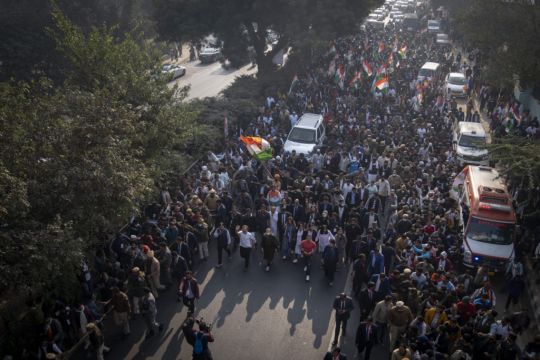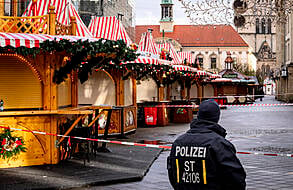Members of India’s main opposition Congress party and thousands of supporters have walked into the capital as part of a five-month cross-country “unity march” seeking to challenge what they say is a “hate-filled” version of the country under the Hindu nationalist government.
Thousands of party workers and senior leaders were led by Rahul Gandhi, a leader of the Congress party and scion of the influential Gandhi family, as they entered New Delhi after passing through eight states.
Flanked by mother Sonia and sister Priyanka, the 52-year-old said the motive for his long walk across the country is to revive the once-mighty Congress party and showcase the “real India” unlike the version offered by Prime Minister Narendra Modi.

“They will spread hate. We will spread love,” Mr Gandhi said, referring to Mr Modi’s ruling Bharatiya Janata Party.
Mr Gandhi set off on the Bharat Jodo Yatra, or Unite India March, in Kanyakumari, a coastal town at the southern tip of India, on September 7.
The march, which is streamed live on a website, is expected to take in 2,218 miles and 12 states before finishing in Indian-controlled Kashmir by February.
Passing through hundreds of villages and towns, the march has attracted farmers worried about rising debt, students complaining about increasing unemployment, civil society members and rights activists who say India’s democratic health is in decline.
Mr Gandhi has shed his formerly clean-shaven look for a thick beard and slept in shipping container cabins during night stops.
In impassioned speeches during the march, he has often targeted Mr Modi and his government for doing little to address growing economic inequality in India, rising religious polarisation, and the threat posed by China.

The armies of India and China have been locked in a bitter stand-off in the mountainous Ladakh region since 2020. Despite more than a dozen rounds of talks at military, political and diplomatic levels, the stand-off has continued.
Mr Modi’s party has dismissed Mr Gandhi’s march and speeches as a political gimmick to regain his “lost credibility”.
“The character of the Congress has been to break India,” the party said in a tweet on Saturday.
Hindu nationalism has surged under Mr Modi and his party, which have been criticised over rising hate speech and violence against Muslims in recent years. Opponents say Mr Modi’s silence emboldens right-wing groups and threatens national unity, but his party denies this.
Even though the Congress party says Mr Gandhi’s cross-country walk is mainly to re-establish an emotional connection with Indians, the electoral ambitions are hard to miss.
With a national election less than 16 months away, it could determine whether India’s beleaguered opposition can put up a fight against the electoral juggernaut of Mr Modi’s party which won a majority in 2014 and 2019.

In 2019, Mr Modi’s party won 303 out of 543 parliamentary seats, in part due to its Hindu nationalistic agenda. Congress was a distant second with 52 seats.
Since he came to power for the first time in 2014, the Congress party has also suffered crushing defeats in a series of state polls, and currently rules only three out of 28 states.
Plagued by leadership crisis and electoral routs, the party in October elected its first non-Gandhi president for 24 years in an attempt to shed an image of being run by a single dynasty.
The party has been led by non-family members in the past, but Sonia and Rahul Gandhi had been at its helm since 1998.
In November, polling agency C-Voter said Mr Gandhi’s popularity ratings have seen a slight jump since the march began, from 29% to 31%. The marginal improvement remains well below Mr Modi’s 66%.







